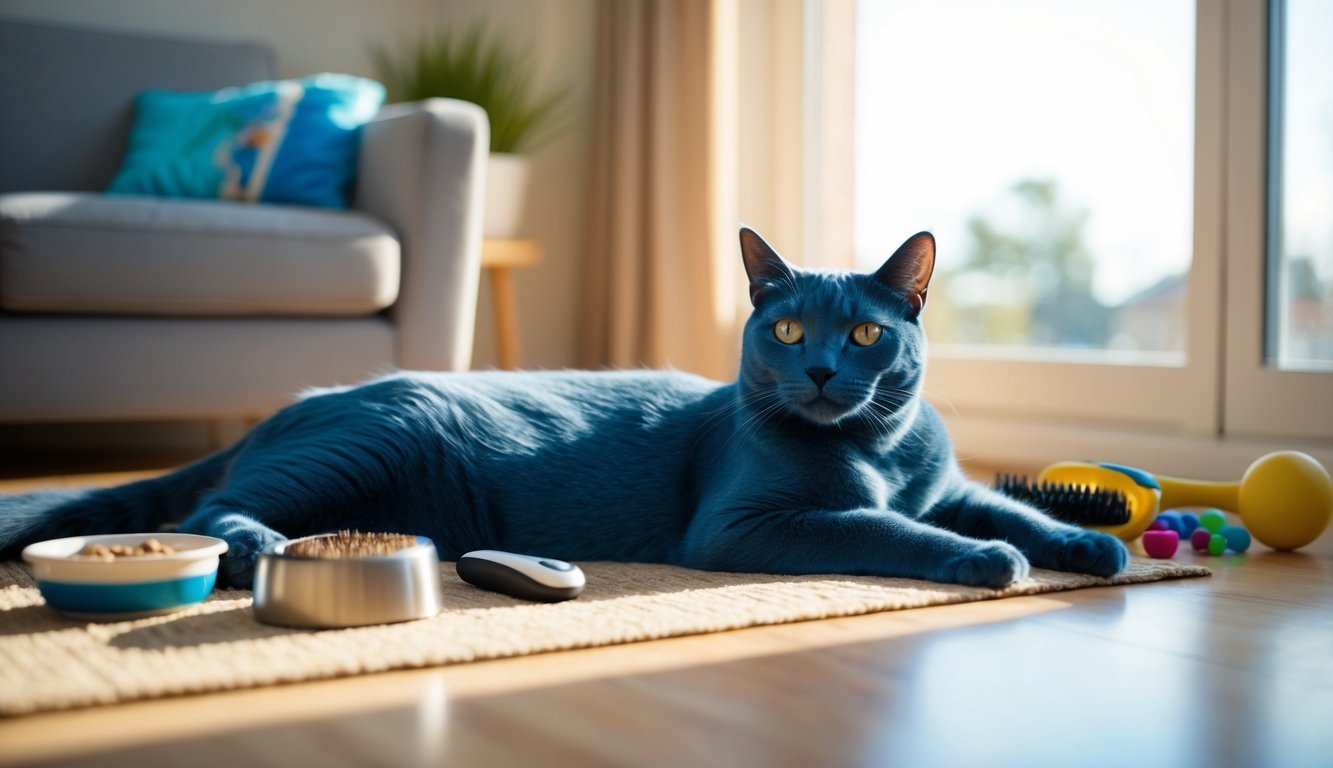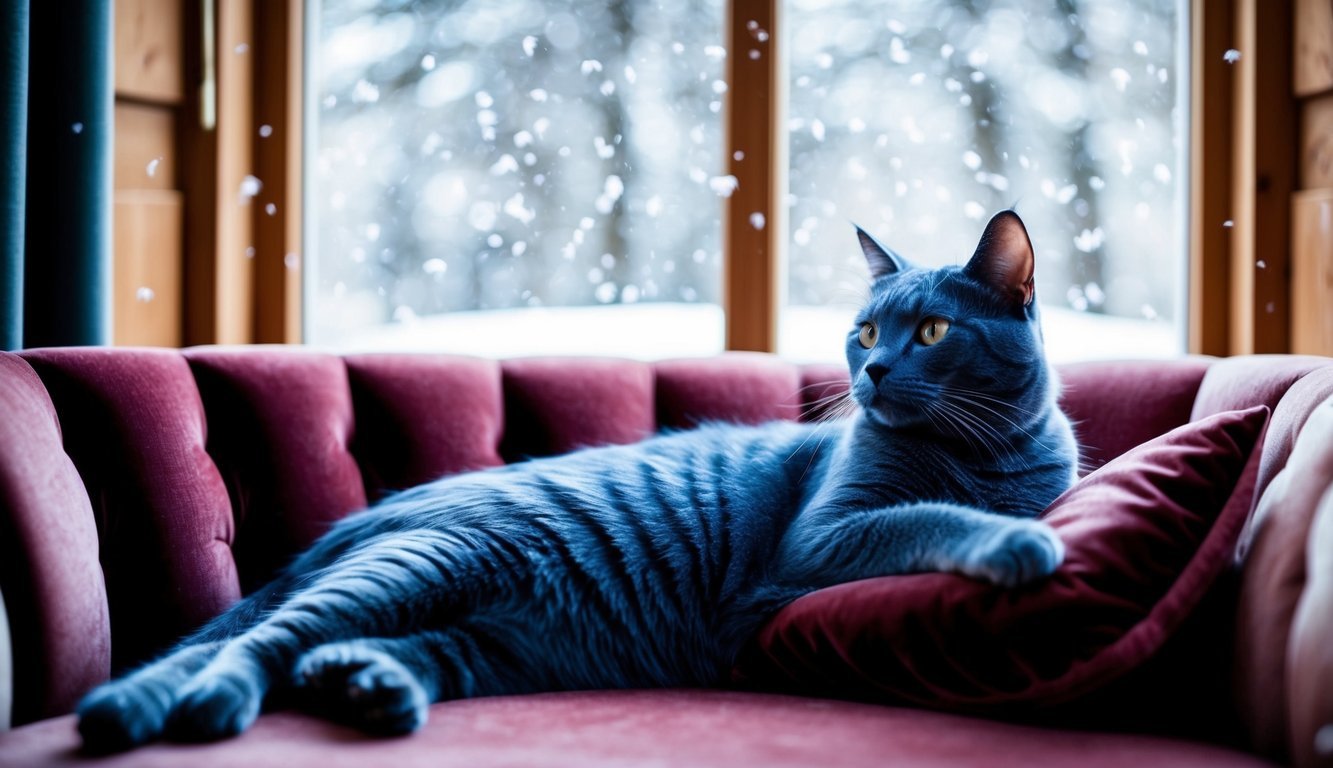Have you ever seen a cat with a shimmering blue-gray coat that looks like it’s made of velvet? That’s probably a Russian Blue! These striking kitties are known for their unique color and piercing green eyes.
Russian Blues are medium-sized cats with short, dense fur that feels soft and plush when you pet them. Their coat color can range from light silver to dark slate gray, but it always has that special bluish tinge.
These cats aren’t just pretty faces though – they’re also known for being smart, loyal, and great companions.
Russian Blues have an interesting history.
Some people think they came from northern Russia, maybe even from the Archangel Isles.
There’s even a rumor that Russian czars used to keep these cats! While we can’t be sure about that, we do know that Russian Blues have been charming cat lovers for over a century with their good looks and sweet personalities.
Breed Overview
Russian Blue cats are known for their striking appearance and gentle personality.
These elegant felines have a rich history and make wonderful companions.
Physical Characteristics
Russian Blues have a distinctive look that sets them apart.
Their coat is short, dense, and uniformly blue-gray with a silvery sheen.
This double coat feels plush to the touch.
Their almond-shaped eyes are a vivid green, adding to their captivating appearance.
These cats are medium-sized, typically weighing 7-12 pounds.
They have a lean, muscular build with long legs and a graceful, elegant posture.
Russian Blues have wedge-shaped heads with prominent whisker pads, giving them a sweet expression.
Their ears are large and pointed, set wide apart on their head.
You’ll notice their tail is long and tapered, adding to their overall sleek look.
Personality Traits
Russian Blues are known for being gentle and affectionate with their families.
They’re loyal cats who form strong bonds with their humans.
You’ll find them to be playful and intelligent, enjoying interactive toys and puzzle games.
These cats are generally quiet and well-mannered.
They’re not overly vocal but may softly meow to get your attention.
Russian Blues can be shy around strangers but warm up once they feel comfortable.
They’re adaptable cats who do well in various living situations.
You’ll appreciate their independent nature, as they can entertain themselves when you’re busy.
However, they also enjoy spending quality time with you.
Historical Significance
Russian Blues have an intriguing history that adds to their allure.
They’re believed to have originated in the port city of Arkhangelsk in northern Russia.
Legend has it that these cats were favorites of Russian Czars and featured in Russian folklore.
The breed made its way to England and Northern Europe in the 1860s.
They were initially shown as “Archangel Cats” due to their place of origin.
Russian Blues faced challenges during World War II but were revived through breeding efforts.
In the United States, Russian Blues were crossed with Siamese cats to improve their body type and eye color.
Today, they’re recognized by major cat associations and prized for their beauty and gentle nature.
Health and Care

Russian Blues are generally healthy cats with few genetic issues.
They need a balanced diet, regular exercise, minimal grooming, and routine vet checkups to stay in top shape.
Diet and Feeding
Feed your Russian Blue a high-quality cat food rich in protein.
Offer both wet and dry food to keep them hydrated.
Measure portions carefully to prevent obesity.
Adult cats usually need 2-3 small meals a day.
Avoid human foods like chocolate, onions, and garlic.
These can be toxic to cats.
Fresh water should always be available.
As Russian Blues age, they may need special senior cat food.
Talk to your vet about the best diet for your cat’s age and health needs.
Exercise and Play
Russian Blues are active cats who need daily play.
Set aside 15-30 minutes twice a day for playtime.
Use toys that mimic prey, like wand toys with feathers or mice.
Try puzzle feeders to keep your cat’s mind sharp.
Hide treats around the house for them to “hunt.”
Provide a cat tree for climbing and scratching.
This helps them stay fit and protects your furniture.
Some Russian Blues enjoy playing fetch.
Toss small toys for them to chase and bring back.
Grooming Needs
Russian Blues have short, dense coats that are easy to care for.
Brush your cat once a week to remove loose fur and spread skin oils.
Trim nails every 2-3 weeks.
Check ears weekly for dirt or signs of infection.
Brush your cat’s teeth regularly with cat-safe toothpaste.
This helps prevent dental disease.
Russian Blues shed less than many other breeds.
They’re a good choice if you want a low-maintenance cat.
Common Health Issues
While Russian Blues are generally healthy, watch for these issues:
- Obesity: Keep an eye on your cat’s weight and adjust food portions as needed.
- Dental problems: Regular teeth brushing and vet cleanings help prevent issues.
- Eye conditions: Look for squinting, redness, or discharge.
- Urinary tract infections: Watch for frequent urination or straining in the litter box.
Take your Russian Blue for yearly vet checkups.
Older cats may need more frequent visits.
Keep up with vaccinations and parasite prevention.
Spay or neuter your cat to prevent certain health issues and unwanted litters.
Living with a Russian Blue

Russian Blues make great companions.
They’re smart, gentle, and don’t shed much.
These cats bond closely with their owners but can be shy around strangers.
Behavior and Training
Russian Blues are pretty easy to train.
They’re clever and like to please you.
You can teach them tricks like fetch or to use a scratching post.
These cats learn quickly, so use positive reinforcement.
Russian Blues are quiet and well-behaved.
They don’t meow much, which is nice if you like peace and quiet.
They’re playful but not hyper.
You’ll need to give them toys and playtime to keep them happy.
These cats are clean and usually use the litter box without problems.
They groom themselves a lot, so you won’t need to bathe them often.
Compatibility with Families
Russian Blues can fit well in many homes.
They’re good with kids if the kids are gentle.
These cats are patient and rarely scratch.
They get along with other pets too.
Russian Blues are social but not needy.
They’ll hang out with you but also enjoy alone time.
If you have allergies, a Russian Blue might work for you.
They shed less than other cats and make less of the protein that causes allergies.
Russian Blues live long, often 15-20 years.
They’re a good choice if you want a lifelong friend.
Adoption Tips
When looking to adopt a Russian Blue, check shelters first.
Pure Russian Blues are rare in shelters, but you might find a mix.
If you want a purebred, look for a good breeder.
Ask to see health records and meet the parents.
Expect to pay $400-$1000 for a kitten.
Before you adopt, make sure you’re ready for a long-term pet.
Russian Blues need daily play and attention.
They also need regular vet care.
Set up a quiet space for your new cat.
Russian Blues can be shy at first.
Give them time to adjust to their new home.


